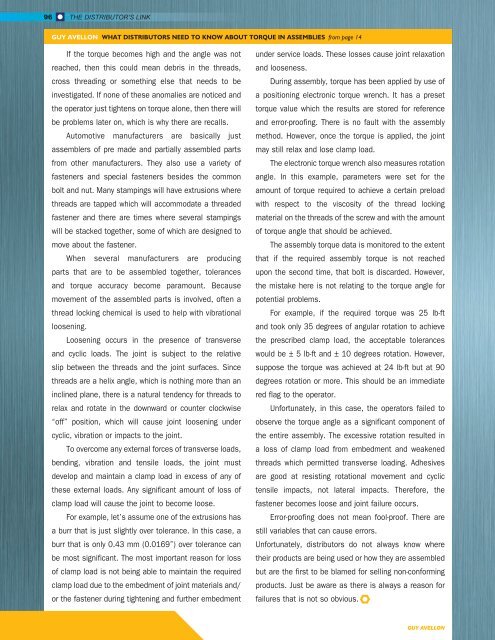SUMMER 2023
Distributor's Link Magazine Summer 2023 / Vol 46 No 3
Distributor's Link Magazine Summer 2023 / Vol 46 No 3
You also want an ePaper? Increase the reach of your titles
YUMPU automatically turns print PDFs into web optimized ePapers that Google loves.
96<br />
THE DISTRIBUTOR’S LINK<br />
GUY AVELLON WHAT DISTRIBUTORS NEED TO KNOW ABOUT TORQUE IN ASSEMBLIES from page 14<br />
If the torque becomes high and the angle was not<br />
reached, then this could mean debris in the threads,<br />
cross threading or something else that needs to be<br />
investigated. If none of these anomalies are noticed and<br />
the operator just tightens on torque alone, then there will<br />
be problems later on, which is why there are recalls.<br />
Automotive manufacturers are basically just<br />
assemblers of pre made and partially assembled parts<br />
from other manufacturers. They also use a variety of<br />
fasteners and special fasteners besides the common<br />
bolt and nut. Many stampings will have extrusions where<br />
threads are tapped which will accommodate a threaded<br />
fastener and there are times where several stampings<br />
will be stacked together, some of which are designed to<br />
move about the fastener.<br />
When several manufacturers are producing<br />
parts that are to be assembled together, tolerances<br />
and torque accuracy become paramount. Because<br />
movement of the assembled parts is involved, often a<br />
thread locking chemical is used to help with vibrational<br />
loosening.<br />
Loosening occurs in the presence of transverse<br />
and cyclic loads. The joint is subject to the relative<br />
slip between the threads and the joint surfaces. Since<br />
threads are a helix angle, which is nothing more than an<br />
inclined plane, there is a natural tendency for threads to<br />
relax and rotate in the downward or counter clockwise<br />
“off” position, which will cause joint loosening under<br />
cyclic, vibration or impacts to the joint.<br />
To overcome any external forces of transverse loads,<br />
bending, vibration and tensile loads, the joint must<br />
develop and maintain a clamp load in excess of any of<br />
these external loads. Any significant amount of loss of<br />
clamp load will cause the joint to become loose.<br />
For example, let’s assume one of the extrusions has<br />
a burr that is just slightly over tolerance. In this case, a<br />
burr that is only 0.43 mm (0.0169”) over tolerance can<br />
be most significant. The most important reason for loss<br />
of clamp load is not being able to maintain the required<br />
clamp load due to the embedment of joint materials and/<br />
or the fastener during tightening and further embedment<br />
under service loads. These losses cause joint relaxation<br />
and looseness.<br />
During assembly, torque has been applied by use of<br />
a positioning electronic torque wrench. It has a preset<br />
torque value which the results are stored for reference<br />
and error-proofing. There is no fault with the assembly<br />
method. However, once the torque is applied, the joint<br />
may still relax and lose clamp load.<br />
The electronic torque wrench also measures rotation<br />
angle. In this example, parameters were set for the<br />
amount of torque required to achieve a certain preload<br />
with respect to the viscosity of the thread locking<br />
material on the threads of the screw and with the amount<br />
of torque angle that should be achieved.<br />
The assembly torque data is monitored to the extent<br />
that if the required assembly torque is not reached<br />
upon the second time, that bolt is discarded. However,<br />
the mistake here is not relating to the torque angle for<br />
potential problems.<br />
For example, if the required torque was 25 lb-ft<br />
and took only 35 degrees of angular rotation to achieve<br />
the prescribed clamp load, the acceptable tolerances<br />
would be ± 5 lb-ft and ± 10 degrees rotation. However,<br />
suppose the torque was achieved at 24 lb-ft but at 90<br />
degrees rotation or more. This should be an immediate<br />
red flag to the operator.<br />
Unfortunately, in this case, the operators failed to<br />
observe the torque angle as a significant component of<br />
the entire assembly. The excessive rotation resulted in<br />
a loss of clamp load from embedment and weakened<br />
threads which permitted transverse loading. Adhesives<br />
are good at resisting rotational movement and cyclic<br />
tensile impacts, not lateral impacts. Therefore, the<br />
fastener becomes loose and joint failure occurs.<br />
Error-proofing does not mean fool-proof. There are<br />
still variables that can cause errors.<br />
Unfortunately, distributors do not always know where<br />
their products are being used or how they are assembled<br />
but are the first to be blamed for selling non-conforming<br />
products. Just be aware as there is always a reason for<br />
failures that is not so obvious.<br />
GUY AVELLON
















